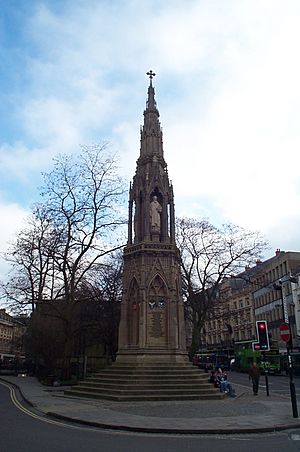Martyrs' Memorial, Oxford facts for kids

The Martyrs' Memorial is a tall stone monument in Oxford, England. It stands where three streets meet: St Giles', Magdalen Street, and Beaumont Street. This memorial honors important people from the 1500s known as the Oxford Martyrs.
Why the Memorial Was Built
The monument was built about 300 years after some very important events in English history. It remembers three men: Hugh Latimer, who was a bishop, Nicholas Ridley, also a bishop, and Thomas Cranmer, who was the Archbishop of Canterbury.
These men were burned at the stake in Oxford in 1555 and 1556. They were found guilty of heresy because of their Protestant beliefs. This happened during a time called the English Reformation, when there were big changes in the Church in England.
In the 1800s, a group of Anglican church leaders, including Rev. Charles Pourtales Golightly, raised money to build this memorial. They were concerned about a movement called the Oxford Movement. This movement was bringing some Catholic ideas back into the Church of England. The people who built the memorial wanted to show that the university and the church in Oxford were still strongly Protestant.
What the Memorial Looks Like
The famous architect George Gilbert Scott designed the Martyrs' Memorial. It was finished in 1843 after two years of work. The monument is built in a style called Victorian Gothic. It looks a bit like the tall, pointed top of a cathedral.
The design was inspired by special crosses called Eleanor crosses. These were built by King Edward I a long time ago to remember his wife, Queen Eleanor.
Henry Weekes sculpted the three statues on the memorial. These statues show Thomas Cranmer, Hugh Latimer, and Nicholas Ridley. The monument is a very important historical building, listed as Grade II*.
On the base of the memorial, there is an inscription. It says that the monument was built to honor God and to remember Thomas Cranmer, Nicholas Ridley, and Hugh Latimer. It explains that they were leaders in the Church of England who were burned near that spot. They died for the truths they believed in, which were different from the beliefs of the Church of Rome at that time. The inscription also says they were happy to suffer for their faith. People paid for the monument through donations in 1841.
The actual place where these men were executed is very close by. It's in Broad Street, just outside where the old city walls used to be. You can see an iron cross set into the road there, marking the exact spot.
The Memorial Today
Over time, the Martyrs' Memorial started to show its age. But in 2003, it was fully repaired and cleaned. The city council of Oxford and the Oxford Preservation Trust helped pay for this important restoration work.
There's a fun story that students in the past sometimes told tourists. They would pretend the memorial was the spire of an underground church. They would even say you could tour it for a small fee! This would lead tourists down some nearby stairs, which actually just went to the public toilets.
See also
 In Spanish: Martyrs' Memorial (Oxford) para niños
In Spanish: Martyrs' Memorial (Oxford) para niños



